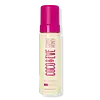Coco & Eve Sunny Honey Bali Bronzing Foam Versus bondi sands Technocolor 1 Hour Express Self Tanning Foam
What's inside
What's inside
 Key Ingredients
Key Ingredients

 Benefits
Benefits

 Concerns
Concerns

 Ingredients Side-by-side
Ingredients Side-by-side

Water
Skin ConditioningDihydroxyacetone
Skin ConditioningGlycerin
HumectantPentylene Glycol
Skin ConditioningLotus Maritimus Flower/Leaf Extract
AntioxidantMusa Sapientum Fruit Extract
Skin ConditioningCarica Papaya Fruit Extract
Skin ConditioningCocos Nucifera Fruit Extract
EmollientFicus Carica Fruit Extract
HumectantGarcinia Mangostana Fruit Extract
Skin ConditioningMangifera Indica Fruit Extract
Skin ConditioningTheobroma Cacao Seed Extract
AntioxidantErythrulose
TanningCoconut Oil Glycereth-8 Esters
CleansingPEG-40 Hydrogenated Castor Oil
EmulsifyingTrideceth-9
EmulsifyingHydroxypropyl Methylcellulose
Emulsion StabilisingSodium Cocoyl Glutamate
CleansingPropylene Glycol
HumectantTrisodium Ethylenediamine Disuccinate
Parfum
MaskingSodium Metabisulfite
AntioxidantSodium Benzoate
MaskingPotassium Sorbate
PreservativeCitric Acid
BufferingCI 14700
Cosmetic ColorantCI 19140
Cosmetic ColorantCI 42090
Cosmetic ColorantWater, Dihydroxyacetone, Glycerin, Pentylene Glycol, Lotus Maritimus Flower/Leaf Extract, Musa Sapientum Fruit Extract, Carica Papaya Fruit Extract, Cocos Nucifera Fruit Extract, Ficus Carica Fruit Extract, Garcinia Mangostana Fruit Extract, Mangifera Indica Fruit Extract, Theobroma Cacao Seed Extract, Erythrulose, Coconut Oil Glycereth-8 Esters, PEG-40 Hydrogenated Castor Oil, Trideceth-9, Hydroxypropyl Methylcellulose, Sodium Cocoyl Glutamate, Propylene Glycol, Trisodium Ethylenediamine Disuccinate, Parfum, Sodium Metabisulfite, Sodium Benzoate, Potassium Sorbate, Citric Acid, CI 14700, CI 19140, CI 42090
Water
Skin ConditioningDihydroxyacetone
Skin ConditioningPropylene Glycol
HumectantTrideceth-9
EmulsifyingPolysorbate 20
EmulsifyingPEG-5 Ethylhexanoate
EmulsifyingGlycerin
HumectantErythrulose
TanningEthoxydiglycol
HumectantAloe Vera Callus Extract
AntioxidantCocos Nucifera Water
MaskingPEG-12 Dimethicone
Skin ConditioningPEG-12 Allyl Ether
PEG-12
HumectantDisodium EDTA
Ethylhexylglycerin
Skin ConditioningPanthenol
Skin ConditioningCI 14700
Cosmetic ColorantCI 19140
Cosmetic ColorantCI 42090
Cosmetic ColorantPhenoxyethanol
PreservativeWater, Dihydroxyacetone, Propylene Glycol, Trideceth-9, Polysorbate 20, PEG-5 Ethylhexanoate, Glycerin, Erythrulose, Ethoxydiglycol, Aloe Vera Callus Extract, Cocos Nucifera Water, PEG-12 Dimethicone, PEG-12 Allyl Ether, PEG-12, Disodium EDTA, Ethylhexylglycerin, Panthenol, CI 14700, CI 19140, CI 42090, Phenoxyethanol
Ingredients Explained
These ingredients are found in both products.
Ingredients higher up in an ingredient list are typically present in a larger amount.
Ci 14700, also known as Red No. 4, is a synthetic red dye derived from petroleum. It is water soluble.
CI 19140 is also known as Tartrazine. Tartrazine is a synthetic dye used in cosmetics, foods, and medicine to add a yellow color.
Tartrazine is created from petroleum and is water-soluble.
Some people may experience allergies from this dye, especially asthmatics and those with an aspirin intolerance.
Learn more about CI 19140Ci 42090 is a synthetic dye created from petroleum. It is used to give a bright blue color to cosmetics, medicine, and food.
Dihydroxyacetone, or DHA, is a simple sugar. It is frequently used in self-tanning products.
DHA binds to the amino acids in your dead skin cells to create a brown/orange color. Darkening begins to kick in a few hours after application and will continue to develop for up to 3 days. This ingredient can be drying.
Both the US and the EU have approved DHA in self-tanning products. In the EU, DHA is allowed at a maximum concentration of 10%. Most tanning products usually contain amounts between 3-5%.
If you are pregnant or have underlying medical conditions, it is best to speak with a dermatologist about using self-tanning products.
Learn more about DihydroxyacetoneWe don't have a description for Erythrulose yet.
Glycerin is already naturally found in your skin. It helps moisturize and protect your skin.
A study from 2016 found glycerin to be more effective as a humectant than AHAs and hyaluronic acid.
As a humectant, it helps the skin stay hydrated by pulling moisture to your skin. The low molecular weight of glycerin allows it to pull moisture into the deeper layers of your skin.
Hydrated skin improves your skin barrier; Your skin barrier helps protect against irritants and bacteria.
Glycerin has also been found to have antimicrobial and antiviral properties. Due to these properties, glycerin is often used in wound and burn treatments.
In cosmetics, glycerin is usually derived from plants such as soybean or palm. However, it can also be sourced from animals, such as tallow or animal fat.
This ingredient is organic, colorless, odorless, and non-toxic.
Glycerin is the name for this ingredient in American English. British English uses Glycerol/Glycerine.
Learn more about GlycerinPropylene Glycol is an odorless, colorless liquid. As a humectant, it helps skin retain moisture. It also aids in delivering active ingredients.
Another role of this ingredient is preventing a product from melting or freezing. Propylene glycol also adds antimicrobrial properties to a product, elongating product lifespan.
This ingredient is considered an organic alcohol and commonly added into both cosmetics and foods.
Those with sensitive skin or conditions may develop a rash when using this ingredient.
Learn more about Propylene GlycolWe don't have a description for Trideceth-9 yet.
Water. It's the most common cosmetic ingredient of all. You'll usually see it at the top of ingredient lists, meaning that it makes up the largest part of the product.
So why is it so popular? Water most often acts as a solvent - this means that it helps dissolve other ingredients into the formulation.
You'll also recognize water as that liquid we all need to stay alive. If you see this, drink a glass of water. Stay hydrated!
Learn more about Water